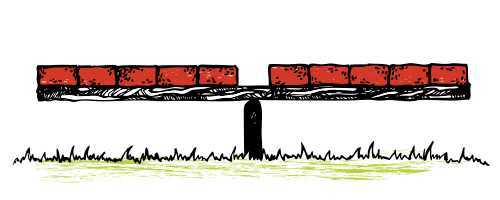Managing Tension
Managing tension
You have something you want to change: a thought process or habit you want to adjust, fix or pivot toward.Consider a bunch of bricks on a seesaw. Right now all the bricks are stacked on one side. This is the way you have been. To make a change, most people don’t do enough. They do one small thing.And nothing happens.
To make a change, most people don’t do enough. They do one small thing.And nothing happens. You've started a shift. Maybe you moved that brick back to where it was, and then out again.Making a shift does not account for:
You've started a shift. Maybe you moved that brick back to where it was, and then out again.Making a shift does not account for:
- a lifetime of doing it the other way
- the environment that made you that way
- the pressure from friends to stay that way
- and a whole repertoire of old habits
Some say, to make a change, you have to be extreme. Go all the way the other way. Stop smoking, sold turkey. Start going to the gym every day. Just jump in the deep end. Doing that means that you are trying one form of being "all in" - by stacking a huge pile of bricks on the other side. This is what most people envision as success. You will have "arrived" if life looks like the opposite. If you were depressed, this is what happy looks like. If you were in a slump, this is what energy and vitality look like. This new you sounds extreme and exciting. You will think you’re going to be completely changed.But, your history of doing things the other way is still there. So really this is what you needed to do: move one brick at a time, until you have a full spectrum of behaviors and visions of success to draw from. This is not the same as balance. This is about establishing small habits that lead to managing the teetering that happens when you go too far toward either end of the seesaw.
This is what most people envision as success. You will have "arrived" if life looks like the opposite. If you were depressed, this is what happy looks like. If you were in a slump, this is what energy and vitality look like. This new you sounds extreme and exciting. You will think you’re going to be completely changed.But, your history of doing things the other way is still there. So really this is what you needed to do: move one brick at a time, until you have a full spectrum of behaviors and visions of success to draw from. This is not the same as balance. This is about establishing small habits that lead to managing the teetering that happens when you go too far toward either end of the seesaw. By managing the middle (meaning you avoid extremes) new skills will sink in, and become your new normal.
By managing the middle (meaning you avoid extremes) new skills will sink in, and become your new normal.

Example:
You have a tendency to blame others for your situation. We all do this. You realize this is hurting your life. You think, “I should stop doing that. What got me here won't get me there. I should take some responsibility.”So you try something new:
You realize this is hurting your life. You think, “I should stop doing that. What got me here won't get me there. I should take some responsibility.”So you try something new: But that doesn't quite do enough. You are still not quite there yet. You need to try more, in a way that will feel like you are going too far.So you think, “Absolutely everything is my fault. All of it. It’s my fault the world is the way it is. It’s my responsibility to fix everything I don’t love. It’s my fault that others act the way they do towards me.”Sounds extreme, right? It will feel like this:
But that doesn't quite do enough. You are still not quite there yet. You need to try more, in a way that will feel like you are going too far.So you think, “Absolutely everything is my fault. All of it. It’s my fault the world is the way it is. It’s my responsibility to fix everything I don’t love. It’s my fault that others act the way they do towards me.”Sounds extreme, right? It will feel like this: You try to think this new way. Sometimes you can actually get there and embody that new voice. You are trying on something new, hearing a new inner voice.But you still can’t help feeling that some things are not your fault. Your old voice still wants to be heard.
You try to think this new way. Sometimes you can actually get there and embody that new voice. You are trying on something new, hearing a new inner voice.But you still can’t help feeling that some things are not your fault. Your old voice still wants to be heard. That’s OK. Now you’re working the middle a little more. This back and forth conversation with "both-and" starts to sink in and becomes your new normal way of thinking.
That’s OK. Now you’re working the middle a little more. This back and forth conversation with "both-and" starts to sink in and becomes your new normal way of thinking.

More examples:
The best and most effective changes I’ve made in my life seemed crazy at first because they seemed to so extreme. I’m going to be writing about more of them in the future, and I’ll keep them listed here:
